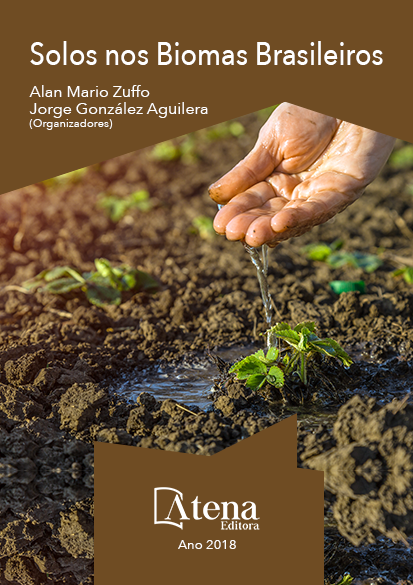
BIOMASSA E ATIVIDADE MICROBIANA EM DIFERENTES USOS DO SOLO NA REGIÃO DO CERRADO - MUNICIPIO DE PALMAS, TO
O estudo da quantidade e da atividade
da biomassa microbiana pode fornecer subsídios
importantes para o planejamento do uso correto
da terra. Este trabalho tem como objetivo
compreender as relações existentes entre o uso
e a Respiração e Biomassa Microbiana do solo.
Os tratamentos foram uma área sob pastagem,
outra cultivada com Eucalyptus spp., outra com
banana orgânica e outra área com agricultura
convencional. A Respiração microbiana (RMS)
foi determinada pelo método da captura, em
solução de NaOH, do CO2
evoluído do solo
com uso de câmaras de incubação. A biomassa
microbiana do solo (BMS), foi determinada pelo
método da Respiração Induzida pelo Substrato
(RIS). Os valores médios encontrados para
RMS: 0,28 C-CO2 mg Kg-1 h-1, 0,84 C-CO2 mg
Kg-1 h-1, 1,08 C-CO2
mg Kg-1 h-1e 1,54 C-CO2
mg
Kg-1 h-1, respectivamente solos sob agricultura,
pastagem, eucalipto e banana orgânica. O solo
sob cultivo orgânico apresentando os maiores
valores, apontando um maior aporte de material
orgânico quando comparados com os outros
usos. Para BMS, o resultado médio encontrado
foi 65,21 µg C g-1, 181,2 µg C g-1, 237,3 µg
C g-1 e 237,3 µg C g-1, respectivamente solos
sob agricultura, eucalipto, pastagem, e banana
orgânica. O resultado idêntico nas áreas de
pasto e banana podem ser justificados pela
maior quantidade de matéria orgânica, seja
pela adubação orgânica aplicada no cultivo
da banana, seja pelo esterco dos animais no
período em que estão pastejando na área. Os
diferentes usos do solo demonstraram alterar
os atributos biológicos do solo
BIOMASSA E ATIVIDADE MICROBIANA EM DIFERENTES USOS DO SOLO NA REGIÃO DO CERRADO - MUNICIPIO DE PALMAS, TO
-
DOI: 10.22533/at.ed.0871814129
-
Palavras-chave: Bioindicadores; qualidade ambiental; matéria orgânica.
-
Keywords: Bioindicators; environmental quality, organic matter
-
Abstract:
The study of the amount and
activity of microbial biomass can provide
important inputs for planning the correct use
of the earth. This work aims to understand the
relationship between the use of Breath and
Microbial Biomass of the soil. The treatments
were an area under pasture, another cultivated
with Eucalyptus spp., Another with organic
banana and another area with conventional agriculture. Microbial respiration (RMS) was determined by the NaOH solution capture
method of CO2 evolved from the soil using incubation chambers. Soil microbial
biomass (BMS) was determined by the Substrate Induced Breathing (RIS) method.
The average values found for RMS were: 0.28 C-CO 2 mg Kg -1 h -1, 0.84 C-CO 2 mg
Kg -1 h -1, 1.08 C-CO 2 mg Kg -1 h -1, 54 C-CO2 mg kg -1 h -1, respectively under
agriculture, pasture, eucalyptus and organic banana. The soil under organic cultivation
presented the highest values, indicating a greater contribution of organic material when
compared with the other uses. For BMS, the average result was 65.21 μg C g-1, 181.2
μg C g-1, 237.3 μg C g-1 and 237.3 μg C g-1, respectively soils under agriculture,
eucalyptus , grassland, and organic banana. The same result in the areas of pasture
and banana can be justified by the greater amount of organic matter, either by the
organic fertilization applied in the banana cultivation, or by the manure of the animals
in the period in which they are grazing in the area. The different uses of the soil have
shown to alter the biological attributes of the soil.
-
Número de páginas: 15
- Michele Ribeiro Ramos


